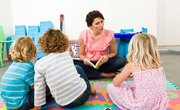Students often groan in dismay when they are given an assignment to write a book report. Boring! There are alternative forms of getting student feedback on books that will spark more of an interest in them. Teachers can ask students to write an interview with their favorite character. Such an assignment is motivating and also fits into various learning objectives set for students by teachers.
The Book Character Interview Assignment
During or after reading a book, most students have a favorite character that interests them. When a student’s interest is sparked by a book character, a book character interview is an opportunity to assess the student’s comprehension and interpretation of the book as a whole, and to have the student participate in one form of a character study. The interview assignment can be effectively used for younger children, but may be best suited for middle grade and high school students.
Planning the Interview
A book character interview can be assigned for feedback as students are in the midst of reading a book or after the completion of reading the book. Ask students to choose a character from the book they are reading, or have read, that interests them. The chosen character should be one that they want to learn more about. To help students assess this, the KWL method of brainstorming can be used. KWL stands for Know, Want to know, and Learned. It requires students to think about what they already know, what they want to know, and what they have learned about the character. The learned section of the KWL method can be part of an assessment strategy at the completion of the assignment. There are available KWL charts that teachers can have their students use.
Thinking about the Character
Students should first think about how the author describes the character’s personality. Doing so may give insight into what kinds of questions to ask and how the character would answer the questions. Students should write some interview questions to ask their chosen character. It may be helpful for students to imagine themselves being an actual interviewer on a talk show or a reporter in formulating the questions. After writing the interview questions, the students should then write answers for each of the questions as they imagine their character would answer them, including any peculiarities of speech that the author gave to that character.
Interview Question Format
The questions that the students write should be open-ended questions that will call for more than just a yes or no or one-word response. Questions that would be good questions within the parameters of Bloom’s taxonomy would include questions such as: "Describe… ." "What might happen if… ?" "What solutions would you suggest for… ?" "What do you think about… ?" "How did you decide about… ?" "How do you feel about…?"
Learning Objectives
The National Council of Teachers of English / International Reading Association standards for the English language arts call for students applying a broad range of strategies to comprehend, interpret, evaluate and appreciate what they read. The project for writing an interview for a book character effectively addresses such standards. The project also fulfills many of the common core standards, which vary slightly from grade to grade and from state to state. The interview also fulfills two of the three educational domains within Bloom’s Taxonomy. The three domains include the cognitive, the affective and the psychomotor. The project addresses the cognitive domain, or the “knowing/head” area. It also addresses the affective domain, or the “feeling/heart" area. It does not address the pshychomotor, or the “doing/ hands” realm.
Related Articles
References
Writer Bio
Melissa Harker Ridenour is a published writer who obtained her Masters Degree from West Virginia University. She has published a print magazine article in Book Links: Connecting Books, Libraries, and Classrooms. Ridenour has written many web articles for websites, including Demand Studios, InfoBarrel, and the Yahoo Contributer Network. In addition, she is a published children's book author and maintains three blogs.











